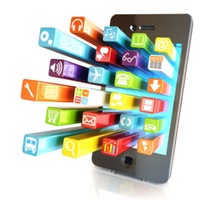As Mobile Revolutionizes Commerce, How Marketers Are Taking Advantage
How many of your daily tasks would be nearly impossible (or at least more difficult) without mobile devices, e-mail and the internet? It’s tough to imagine accomplishing even the simplest of tasks, especially when it comes to buying and selling goods. Mobile has revolutionized commerce, including the way consumers engage, research and ultimately purchase products. […]
How many of your daily tasks would be nearly impossible (or at least more difficult) without mobile devices, e-mail and the internet? It’s tough to imagine accomplishing even the simplest of tasks, especially when it comes to buying and selling goods. Mobile has revolutionized commerce, including the way consumers engage, research and ultimately purchase products.

Here’s how mobile assets are reshaping the commerce landscape and consumer buying behaviors:
1. Showrooming
Today, it is not uncommon for consumers to turn to their mobile devices to research products while in a store. This real-time access to information enables them to conduct their own on-site research on websites like Amazon and eBay for both price and product comparisons.
Large retailers like Best Buy are even using showrooming to compete with their competition through offers that match online and local retailers’ lower prices.
Other brands are implementing reverse showrooming strategies, in which consumers may look up products online, but are driven to complete their purchase in-store. The increase in showrooming should be seen as an incentive for brands to deliver real-time information and innovations to prompt consumers to visit stores in person.
2. Social Shopping
Social media is already becoming increasingly integrated into the brick-and-mortar experience, and mobile engagement is a driving force.
Notable brands like Nordstrom are leading the way with initiatives such as in-store displays showcasing top items pinned on Pinterest. Toyota is innovating the car shopping experience by inviting consumers to participate in Google Hangouts complete with tailored shopping tools and resources for building a customized car.
3. App Marketing
Apps are also bridging the gap between brick-and-mortar retailers and ecommerce sites. Essentially, they have opened up new marketplaces in which both marketers and consumers benefit. For consumers, apps create a personalized digital environment that is extremely user-friendly.
On the marketers’ side, apps provide a direct communication channel with their customer as well as access to real-time, user-level data that helps brands understand their customers’ journey. As a result, marketers become better equipped with knowledge of when to push out notifications, coupons, and deals, as well as deploy in-app targeting and update pertinent brand and consumer information.
In many ways, apps have changed the role of the ecommerce site with their ability to facilitate research either by expediting the process with a quick scan of a QR code or by sifting through personalized content within the app itself.
A great example of a branded app fulfilling timely consumer needs is American Apparel’s mobile app because it complements the in-store experience with outfit pairing suggestions, sale information and interactive product labels made accessible via QR codes.
4. Mobile Payments
One of the main benefits of shopping online is avoiding long checkout lines. Many retailers have risen to the challenge by offering mobile payment systems that empower in-store shoppers to conduct self-service checkout using their smartphones.
A recent study from LexisNexis and Javelin Strategy & Research illustrates how mobile penetration within the retail channel is growing rapidly, with nearly one in ten merchants accepting mobile payments in 2013 — an increase of 50% per year since 2011. An additional 25% expect to begin accepting mobile payments in 2014.
Earlier this year, Starbucks claimed to have over 10 million customers use their mobile payment and app program, which was estimated to drive nearly $1 billion in revenue in 2013.
5. Location-Based Ads
The ability to reach consumers based on their proximity to products, stores or general locales has become a game changer for brands. In fact, it has become more common to see marketers experiment with layering behavioral and intent data on top of location targeting as a means to influence purchasing decisions.
We see this in various mobile-based search retargeting campaigns as many overlay tactics like geo-fencing and keyword targeting to reach consumers on mobile devices.
By combining the power of location and other data-based targeting strategies, advertisers can improve the relevancy of brand messages and effectively drive up performance. A new report by BIA/Kelsey estimates that by 2017, over half of all mobile ad budgets will be allocated to location-targeted ads. While this might be a bit bullish, location is a key factor in the future of commerce.
Above all, the main takeaway is to make sure you have mobile assets in place. Marketers should capitalize on the ability to reach consumers in new and innovative ways. Retailers take note: ease of access, seamless omni-channel experiences, inspiring opportunities for engagement and personalization are the name of the game. The delivery is up to you.
Opinions expressed in this article are those of the guest author and not necessarily MarTech. Staff authors are listed here.
Related stories

![Screen Shot 2014-03-17 at 12.39.35 PM[1]](https://martech.org/wp-content/uploads/2014/03/Screen-Shot-2014-03-17-at-12.39.35-PM1.png)